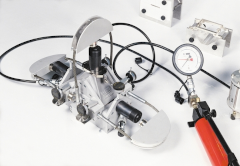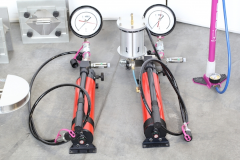Behavior of Joints
ASTM D5607
|
Rock shear box apparatus was originally developed at Imperial college, London, by Professor E. Hoek. It is a simple and practical method of determining the strength and slope stability of rock, both in the field and in the laboratory.
The apparatus consists of a shear box designed to accept samples not larger than 115x125 mm, or alternatively cores up to 102 mm dia. The shear box consists of two halves, the upper being connected to two rams for reversible shearing action and the lower connected to a ram for normal load application. The loads are recorded by Bourdon tube load gauges or by pressure transducers (in this case external datalogger is needed). The normal loading system is complete with an adjustable low friction pressure maintainer to absorb volume changes of the specimen during the shearing action and to ensure a constant vertical stress. Two versions are available: 32-D0548/A: Basic rock shear box apparatus with digital gauges to ASTM D5607 It is supplied complete with: 5 digital gauges 25x0.001 mm (4 vertical and 1 horizontal); 2 mould formers; 2 hand operated pumps for lateral and vertical load fitted with Bourdon gauges. The pump for vertical load is fitted with a pressure maintainer to assure uniform load during the test. 32-D0548/D: Electronic rock shear box apparatus with potentiometric transducers to ASTM D5607 It is supplied complete with; 5 potentiometric transducers with 25mm travel (4 vertical and 1 horizontal); 2 mould formers; 2 hand operated pumps for lateral and vertical load fitted with Bourdon gauges; 2 pressure transducers for the direct acquisition of the load values. The pump for vertical load is fitted with a pressure maintainer to assure uniform load during the test. Displacement and load readings shall be acquired by suitable datalogger that has to be add as accessory. Two versions can be used to complete the testing configuration: standard model with dedicated display suitable for laboratory use or with battery operated model for on-site use. The high alumina cement for the cementation of the sample is available separately. |
|
Joint roughness coefficient test device is used to calculate the JRC of a rock or joint. The device consists of an adjustable inclined plane, on which the rock sample (100 mm max dia.) is placed, separated along the surface where the roughness is to be measured. Then the plane is slowly tilted until sliding of the upper part of the sample on the lower one occurs. From the measured inclination angle it is possible to evaluate the roughness index.
32-B0096: Apparatus for measurement of the joint roughness coefficient (Tilt test)
|







